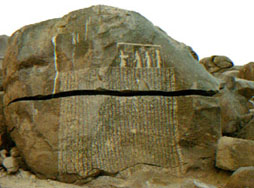|

Boulder at the Island of Sahal
with the myth inscribed on
it
| the SEVEN YEARS'
FAMINE
the PREFACE
This narrative is from the
famous inscription which was discovered on the rock pictured at left on
the Island of Sahal in 1890 by Charles Wilbour.
In the eighteenth year of the king Tcheser (the third king of the third
dynasty), the whole region of the South, the Island of Elephantine, and
the district of Nubia were ruled by the high official Mater. The king sent
a dispatch to Mater informing him that he was in great grief by reason of
the reports which were brought to him into the palace as he sat upon his
throne, and because for seven years there had been no satisfactory
inundation of the Nile. As the result of this grain of every kind was very
scarce, vegetables and garden produce of every kind could not be found,
and in fact the people had very little food to eat, and they were in such
need that men were robbing their neighbors. Men wished to walk out, but
could not do so for want of strength; children were crying for food, young
men collapsed through lack of food, and the spirits of the aged were
crushed to the earth, and they laid themselves down on the ground to die.
In this terrible trouble king Tcheser remembered the god Imhotep, the
son of Ptah of the South
Wall, who, it would seem, had once delivered Egypt from a similar
calamity, but as his help was no longer forthcoming Tcheser asked his
governor Mater to tell him where the Nile rose, and what god or goddess
was its tutelary duty.
In answer to this dispatch Mater made his way immediately to the king
and gave him information on the matters about which he had asked
questions. He told him that the Nile flood came forth from the Island of
Elephantine whereon stood the first city that ever existed; out of it rose
the Sun when he went forth to bestow life upon man, and therefore it is
also called, "Doubly Sweet Life." The spot on the island out of which the
river rose was the double cavern Qerti, which was likened to two breasts,
from which all good things poured forth; this double cavern was, in fact,
the "couch of the Nile," and from it the Nile-god watched until the season
of inundation drew nigh, and then he rushed forth like a vigorous young
man and filled the whole country. At Elephantine he rose to a height of
twenty-eight cubits, but at Diopolis Parva in the Delta he only rose seven
cubits. The guardian of this flood was Khnemu, and it was
he who kept the doors that held it in, and who drew back the bolts at the
proper time.
Mater next went on to describe the temple of Khnemu at
Elephantine and told his royal master that the other gods in were Sept
(Sothis), Anqet, Hapi, Shu, Geb, Nut, Osiris, Horus, Isis and Nephthys, and
after this he enumerated the various products that were found in the
neighborhood, and from which offerings ought to be made to Khnemu. When the
king heard these words he offered up sacrifices to the god, and in due
course went into his temple to make supplication before him.
"I am Khnemu,
the
Creator"
| Finally Khnemu appeared
before him, and said, "I am Khnemu the Creator.
My hands rest upon thee to protect thy person, and to make sound thy body.
I gave thee thine heart... I am he who created himself. I am the primeval
watery abyss, and I am the Nile who riseth at his will to give health for
me to those who toil. I am the guide and director of all men, the
Almighty, the father of the gods, Shu, the mighty
posessor of the earth."
Finally the god promised that the Nile should rise every year, as in
olden time, and described the good which should come upon the land when he
had made an end of the famine. When Khnemu ceased to
speak king Tcheser remembered that the god had complained that no one took
the trouble to repair his shrine, even though stone lay near in abundance,
and he immediately issued a decree in which it was ordered that certain
lands on each side of the Nile near Elephantine should be set apart for
the endowment of the temple of Khnemu, and that a
certain tax should be levied upon every product of the neighborhood, and
devoted to the maintenance of the priesthood of the god; the original text
of the decree was written upon wood, and as this was not lasting, the king
ordered that a copy of it should be cut upon a stone stele which should be
set in a prominent place. the AFTERWARD
It
is not said whether Khnemu kept his
promise to Tscher, but we may assume he did. The form of the narrative of
the Seven Years' Famine summarized above is not older than the Ptolemaic
period, but the subject matter belongs to a much older time, and very
probably represents a tradition which dates from the Early Empire.
Editor's Note: this myth was taken more or less directly from The
Gods of the Egyptians by E.A. Wallis Budge
|





